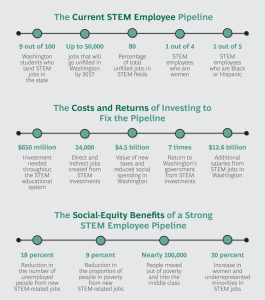Today’s fast-changing world requires students with “twenty-first-century skills.” All too often, however, students in many countries are not acquiring these skills. Innovative education technologies such as adaptive learning platforms and interactive games are beginning to show potential for helping address skills gaps. Delivering on the potential of technology will ultimately require effective collaborations among many players. Read the rest of this entry »
Archive for maj, 2016
How Education Technology Can Help Foster Social and Emotional Skills
To thrive in the 21st century, students must be adept at collaboration, communication, and problem solving—a few of the skills developed through social and emotional learning (SEL). Social and emotional skills can strengthen the labor force, boost academic performance, and produce long-term benefits such as higher rates of employment and educational attainment. Read the rest of this entry »
BCG The Facts About the STEM Employee Pipeline in Washington State
Washington State is home to numerous world-class technology, aerospace, clean-energy, and biomedical companies. Nevertheless, the pipeline for employees in science, technology, engineering, and math—collectively known as STEM—is broken. The state currently cannot meet the demand for STEM jobs with local talent and must instead import those workers from out of state or abroad. As a result, Washington is missing out on creating critical middle-class jobs for all its citizens, especially women, underrepresented minorities, and those with low incomes.
Let’s take a look at the current state of the STEM employee pipeline, the costs and returns of investing to fix it, and the social-equity benefits of creating more STEM jobs in Washington.

Washington State’s economy is booming, producing great jobs that offer competitive salaries in world-class technology, aerospace, clean-energy, and biomedical companies. But a serious problem is lurking behind the boom: a leak in the pipeline for employees to fill the state’s most valuable jobs in science, technology, engineering, and math—collectively known as STEM.
In Great Jobs Within Our Reach, a 2013 joint report by The Boston Consulting Group and the Washington Roundtable, we calculated that, even after importing highly educated workers from out of state and abroad, Washington was missing out on an opportunity to fill as many as 25,000 high-skill jobs—a number that could double by 2017.
Now we estimate that only 9 out of 100 children born in Washington will ultimately end up as employees in a STEM-related field in the state—far fewer than the number of people needed to fill Washington jobs requiring STEM-related skills. (See “The Facts About the STEM Employee Pipeline in Washington State.”) The situation is worse for low-income students, who are two to three times less academically prepared for the STEM workforce than their more affluent peers. Currently, only 40 percent of high school students in Washington graduate with competency in STEM topics. These skills are critical for the state’s citizens, regardless of whether they end up in STEM-related fields.
Creating more STEM jobs would not only boost Washington’s economy, it would also reduce poverty and unemployment, help all Washington families prosper, and create a better-prepared workforce. If Washington can match the practices of high-performing states, such as California and Massachusetts, it could double or triple the number of STEM jobs in the state as well as expand the participation of women and underrepresented minorities in the STEM workforce.
John Wenstrup, Carmen Bona, and Marc Casale
Acknowledgments
The authors would like to thank the following individuals for their generosity in sharing their insights and for allowing us to learn from them: Jeff Knudsen and Vickie Rekow of the College Success Foundation; Jane Broom Davidson of Microsoft; Sam Whiting of Thrive by Five Washington; Patrick D’Amelio, Alex Johnston, and Caroline King of Washington STEM; and Theresa Britschgi, Megan Nelson, and Naria K. Santa Lucia of the Washington State Opportunity Scholarship.
The authors also thank Mickey Butts for his assistance in writing the report and producing the online interactive, and Glen Gunawan and Whitney Haring-Smith, who helped with underlying research and with the report’s writing. Finally, the authors wish to thank Katherine Andrews, Gary Callahan, Dan Coyne, Jon Desrats, Lilith Fondulas, Federico Fregni, Kim Friedman, Abby Garland, Melanie Jarzyniecki, and Sara Strassenreiter for their contributions to the report’s editing, design, and production.
See Opportunity for All: Investing in Washington State’s STEM Education Pipeline, BCG Focus, December 2014.


